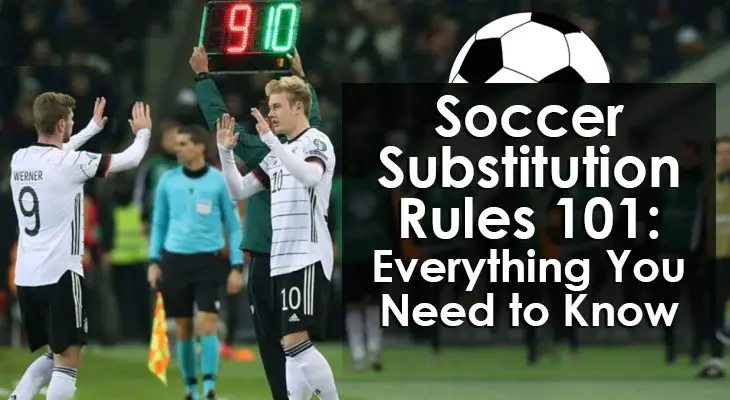Soccer Substitution Rules 101: Everything You Need to Know
In a professional soccer game of ninety (90) minutes, you may see teams make a substitution or two before the game ends.
The soccer substitution rules guiding the number of allowable subs have changed slightly since the coronavirus epidemic of 2020, with some leagues now allowing more substitutions to give players a better chance of recovery.
However, there are still a handful of substitution rules that remain standard procedure.
In this guide, we take a look at the basic rules of player substitutions in soccer, along with other information that is relevant to the topic.
Soccer Substitutions Rules Over the Years:
The 19th Century
In the 19th century, substitutions were not part of the game at all.
The only exceptions were cases wherein a player failed to show up for a game and the team had to replace him with someone else.
The 20th Century
Substitutions were only added to the Laws of the Game in the 20th century, specifically in 1958.
These rules were typically for competitive matches and is under Law 3 of the Laws of the Game, in the Substitution Procedure section.
However, they were initially not in the exact form that they are today.
For example, substitutions were not allowed in World Cup finals until 1970.
Also, teams were only allowed one (1) substitution per game until 1988 -- when the number increased to two (2), with five options on the bench.
In 1994, the number was further increased to two plus one (2+1) in cases of an injured goalkeeper, before the caveat of an injured goalkeeper was removed in 1995.
By that time, the number of potential substitutes to choose from had also increased to seven (7).
The 21st Century
In 2016, there were trials for four (4) substitutions in cases where the game went on to extra time in certain competitions.
One such case was the UEFA Euro 2016 Championship.
As mentioned earlier, the COVID-19 pandemic of 2020 forced another review to allow a maximum of five (5) substitutions plus an additional one (1) in extra time in competitions where it applied.
Teams would have three (3) windows of opportunity to make all these substitutions.
These, of course, excludes the changes made in half-time, beginning of extra-time, and half-time of extra-time.
The Federation Internationale de Football Association (best known as FIFA) proposed this adjustment to the International Football Association Board, and was made official for the remainder of 2020 to reduce the impact of fixture congestion across the world.
Since then, most competitions have stuck with the rule, while a few others such as the English Premier League voted for a revert to the previous format -- maximum of three (3) substitutions.
However, as of March 2022, the English Premier League clubs also agreed to go back to five (5) substitutions each game, starting from the 2022/23 Premier League season.

Why Do Teams Make Substitutions?
There are a few reasons why a coach may decide to make a substitution under the modern, updated rules of the game.
a. Tactical Changes
A coach may decide to make a substitution to switch up the formation of the team, based on information gained from watching the game.
For instance, if a team starts off with a 4-4-2 but needs to switch to a 4-3-3 during the game, the coach might have to take a striker out for a midfielder instead.
A tactical change in this context could also mean bringing a player on because the coach believes his skill set can make an impact in a way that the substituted player will not.
Another instance of a tactical change that may require a substitution is a case where a player gets a red or yellow card.
A red card leaves the team in the lurch as they become outnumbered by the opponent.
Here, there is often a need for the coach to make a tactical substitution to try and compensate for the lower number of bodies the team has on the pitch.
b. Discipline
While a red card makes the job of the coach significantly harder, teams can avoid it when a player gets a yellow card instead.
Here, the coach might decide to take caution and bring the player off and avoid a second yellow card, which will leave the team in a difficult position.
c. Time Wasting
This typically applies in two (2) ways.
First, teams can make a substitution toward the end of the game to hold on to a result and frustrate the opposition.
Second, teams can make a substitution the other team clearly has the upper hand and is dominating the game.
The break in play may provide the coach’s team with a much-need breather and put a halt to the momentum of the opponent.
d. Stamina
On average, a player will run up to seven miles over the course of a 90-minute game.
Despite the fact that they are professionals trained for those situations, it may still take a toll on their stamina, especially in high-tempo games.
In cases like that, it is in the best interest of the coach to substitute any tired legs so they do not become a liability to the team.
After all, tired players are more prone to making mistakes.

Additional Substitution Rules in Soccer
Apart from the rules previously discussed, these additional rules of substitutions in professional soccer also apply:
- The team must name substitutes before kick-off, and only these named substitutes may be able to take part in the game.
- A player that has been substituted may not return to the pitch during the game.
- A substitute can only come on during a stoppage in play.
- The coach must get the referee’s permission before making a substitution.
- A substitute must wait for the substituted player to leave the field first, and must then enter the pitch from the halfway line.
- Once a substitute enters the field of play, the substitution is permanent.
- A player can refuse to get substituted, and a player can also refuse to come on.
Final Words
There you have it - a crash course on substitution rules in soccer.
If you have questions that were not addressed, feel free to leave a comment.
Have a good one!

